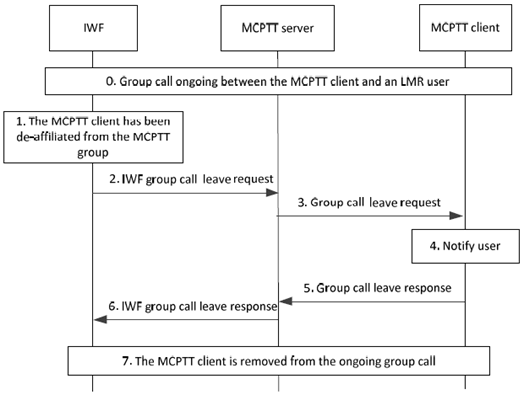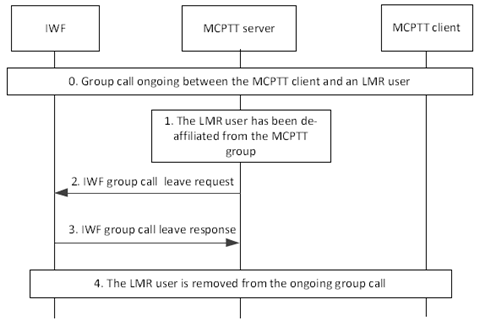Content for TS 23.283 Word version: 19.1.0
1…
10…
10.2…
10.3…
10.3.2
10.3.3…
10.3.4…
10.3.5…
10.3.6…
10.3.7…
10.3.8…
10.4…
10.5…
10.6…
10.6.2…
10.6.3…
10.7…
10.8…
10.11…
10.12…
10.14…
10.15…
10.17…
10.3.6 Exiting group call due to de-affiliation
10.3.6.1 General
10.3.6.2 Exiting group call defined in the LMR system due to de-affiliation
10.3.6.3 Exiting group call defined in the MCPTT system due to de-affiliation
...
...
10.3.6 Exiting group call due to de-affiliation p. 70
10.3.6.1 General p. 70
The following procedures are applicable both for the pre-arranged and chat group calls.
10.3.6.2 Exiting group call defined in the LMR system due to de-affiliation p. 70
Procedures in Figure 10.3.6.2-1 are the signalling control plane procedures for the IWF requesting a newly de-affiliated MCPTT user to leave an ongoing MCPTT group call.
Pre-conditions:
- The MCPTT group is previously defined on the IWF with MCPTT users affiliated to that group. At least one user is an LMR user represented by an MCPTT ID.
- An MCPTT user on the MCPTT client and an LMR user via the IWF, are on an ongoing call.

Step 1.
The MCPTT client is de-affiliated.
Step 2.
The IWF sends an IWF group call leave request to the MCPTT client via the MCPTT server.
Step 3.
The MCPTT server forwards the IWF group call leave request as a group call leave request to the MCPTT client.
Step 4.
The MCPTT user at the MCPTT client is notified about leaving the group call.
Step 5.
The MCPTT client sends the group call leave response to the MCPTT server and leaves the group call.
Step 6.
The MCPTT server forwards the group call leave response to the IWF as an IWF group call leave response.
Step 7.
The MCPTT client is now removed from the ongoing group call.
10.3.6.3 Exiting group call defined in the MCPTT system due to de-affiliation p. 71
Procedures in Figure 10.3.6.3-1 are the signalling control plane procedures for the MCPTT server requesting a newly de-affiliated LMR user to leave an ongoing MCPTT group call.
Pre-conditions:
- The MCPTT group is previously defined on the group management server with MCPTT users affiliated to that group. At least one user is an LMR user represented by an MCPTT ID.
- An MCPTT user on the MCPTT client and an LMR user via the IWF, are on an ongoing call.

Step 1.
The LMR user represented by the IWF has been de-affiliated.
Step 2.
The MCPTT server sends an IWF group call leave request to the LMR user via the IWF.
Step 3.
The IWF sends an IWF group call leave response to the MCPTT server and leaves the group call.
Step 4.
The LMR user represented by the IWF is now removed from the ongoing group call.